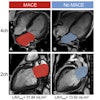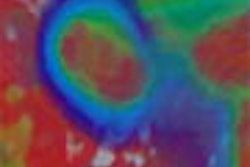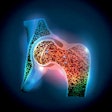There is an old adage that states, "If you blink, you'll miss it."
In the case of BlinkRadiology, however, the Springfield, IL-based start-up radiology software company encourages blinking.
Founded in February by Dr. Matthew Kuhn, BlinkRadiology has developed digital image display software that rapidly alternates new and prior images in front of and over each other. By "blinking" the two images, the technique is designed to improve the accuracy of image interpretation by taking advantage of the human brain's instinctive attraction to motion.
BlinkRadiology's technology was the subject of one of the more intriguing papers at the 2006 RSNA meeting, in which Kuhn presented results of a study in which two radiologists separately using the technology, called the Blink Comparator, were able to improve their detection rates by 18% to 20% over conventional soft-copy reading techniques. (Click here for a demonstration of the concept.)
Kuhn plans to integrate BlinkRadiology's technology into software from multiple PACS vendors on an OEM basis, and sees applications across multiple imaging modalities (except ultrasound) in which new studies can be compared to prior images. He hopes that Blink Comparator will give radiologists an additional tool to perform soft-copy image analysis and identify suspicious areas that might otherwise have gone unnoticed.
Synesthesia concept
Kuhn currently serves as chairman of the radiology department at St. John's Hospital in Springfield and is chief of the division of neuroradiology and clinical professor of radiology, neurology, and neurosurgery at the Southern Illinois University School of Medicine, also in Springfield. He developed Blink Comparator with other radiologists at Southern Illinois, including breast MRI radiologists Dr. Ted Gleason and Dr. Michael Wendel.
Blink Comparator uses grayscale images, rather than color, in a semiautomatic manner analogous to computer-aided detection (CAD). Radiologists can slow or speed the rate of blinking. For larger lesions, Kuhn suggests a slower rate of blinking is preferable, but for smaller lesions, more rapid blinking will draw the eyes to the lesion with greater accuracy.
Kuhn believes the technology is simple to learn. "It is used in conjunction with traditional methods of comparing images or looking at images alone," he said. "There is one extra button for the radiologist to click, and the BlinkRadiology technique will automatically appear on the screen, lighting the images, and alternating the images without the radiologist doing anything more."
The technology is based on synesthesia, which -- in Kuhn's words -- is "a phenomenon by which humans use multiple senses for interpretations of various experiences around them." A more technical definition is a condition in which "a stimulus, in addition to exciting the usual and normally located sensation, gives rise to a subjective sensation of different character or localization (e.g., color hearing, color taste)."1
The synesthesia concept is already employed to some extent in breast MRI, which uses color to distinguish different types of enhancement curves and the difference between benign and malignant nodules. "A malignant curve has a particular shape to it, so the radiologist can recognize it," Kuhn said. "The manufacturers of software for breast MRI make these nodules red, so as soon as a radiologist sees it, they can sense by the color that it is more likely something else. I believe that can be applied to other applications in radiology."
BlinkRadiology currently is working with imaging processing developer Clario Medical Imaging of Seattle to integrate Blink Comparator with Clario's z3D Contrast Acuity software for breast MRI. z3D Contrast Acuity is designed to analyze breast nodules by plotting graphs of enhancement curves and displaying nodules in a 3D format.
"The enhancement springs the lesion up from the flat surface to draw the eye to the main lesion with greater clarity," Kuhn explained. "We are adding the Blink technique to breast MRI interpretation, because the nodules will lose some detail when breast MRI is performed."
Typically, enhanced and unenhanced images must be registered and superimposed almost perfectly to develop the enhancement curve, Kuhn said. The process can cause blurring, which, in turn, degrades image detail. Blinking images, Kuhn maintained, do not need perfect registration.
"We don't need to superimpose the enhancing part of the nodule over the pre-enhanced image," he said. "The human eye is unaffected by that offset. The registration needs to be good for the curve, but it doesn't need to be very close for the blink technique to increase the sensitivity of the radiologists to lesions. It also allows for more detailed morphological evaluations using the z3D software."
There is currently only one Blink Comparator in place, at St. John's Hospital, where it's being used in a clinical trial with Clario's z3D software. The trial is currently going through the Institutional Review Board (IRB) process.
BlinkRadiology is also studying the technology in conjunction with bone scans, showing what Kuhn described as "a dramatic increase in the efficiency of a radiologist to detect changes in bone scans, comparing new and old studies." The company hopes to be able to present that study at the 2007 RSNA meeting.
Vendor relationships
Rather than market Blink Comparator to end users directly, Kuhn sees the key to the company's success in establishing relationships with imaging vendors who can then integrate the technology into their own software, giving radiologists seamless access to Blink Comparator.
In addition to its relationship with Clario, BlinkRadiology has a partnership with Swedish PACS and digital mammography vendor Sectra to integrate BlinkRadiology's imaging technology with Sectra's PACS workstations. Involved in the collaboration is the Linköping-based vendor's U.S. affiliate, Electromek Diagnostic Systems of Troy, IL. BlinkRadiology is also working with RIS and PACS developer DR Systems of San Diego in the area of PACS and bone scans.
With each of these partners, Blink Comparator will need U.S. Food and Drug Administration clearance to go to market, a process that would come as part of the OEM partner's regulatory application.
"The larger goal is to distribute the software more widely to the main PACS vendors, so radiologists will have the technique to compare images no matter which (PACS) vendors they have," Kuhn said.
By Wayne Forrest
AuntMinnie.com staff writer
May 23, 2007
1Stedman's Medical Dictionary, 27th Edition (Baltimore, MD: Lippincott Williams & Wilkins, 2000), p. 1772.
Related Reading
Clario inks breast MR deal with BlinkRadiology, April 27, 2007
Digital 'blink' comparator boosts lesion detection performance, November 26, 2006
Copyright © 2007 AuntMinnie.com



















